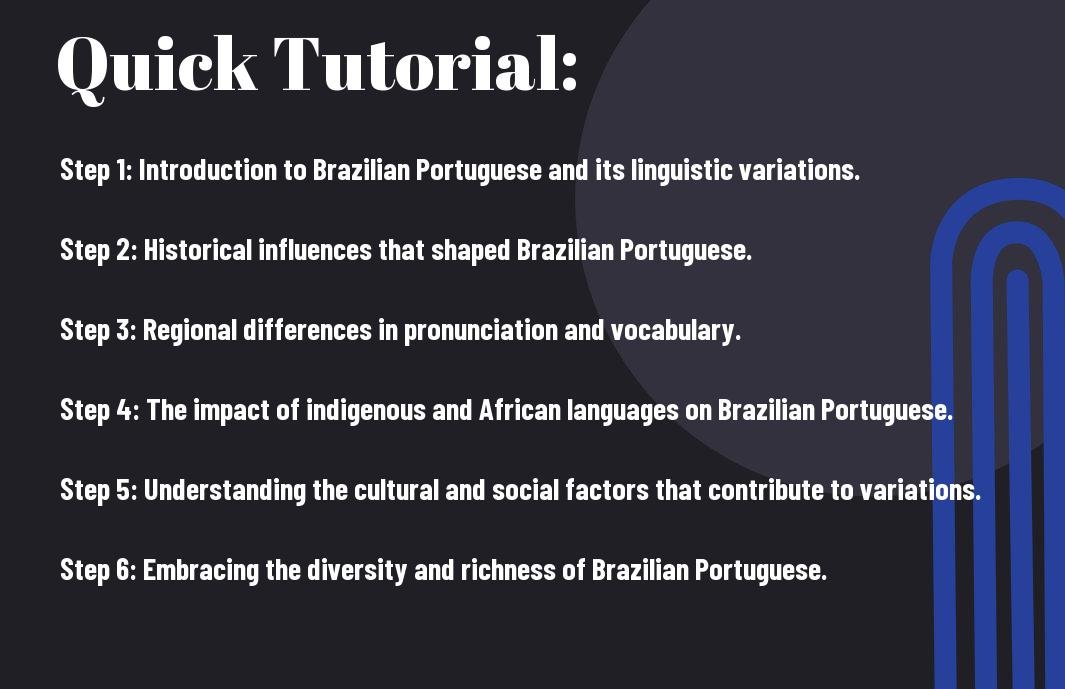Why Is Brazilian Portuguese So Different – Understanding Linguistic Variations
- Home
- Why Is Brazilian Portuguese So Different – Understanding Linguistic Variations

Why Is Brazilian Portuguese So Different – Understanding Linguistic Variations
Epistemologically, Brazilian Portuguese has always been a fascinating subject for linguists and language enthusiasts alike. In this tutorial, I will guide you through the various linguistic variations in Brazilian Portuguese and help you understand why it differs so drastically from European Portuguese. From the influence of indigenous languages and African dialects to the impact of immigration and geographical isolation, the reasons behind the unique characteristics of Brazilian Portuguese are multifaceted and complex. Understanding these variations is not only important for linguistic research, but it can also positively impact your language learning journey and cultural appreciation. So stay tuned as I demystify the differences in Brazilian Portuguese and provide valuable insights on this captivating language variation.
Key Takeaways:
- Historical Influences: The unique linguistic variation in Brazilian Portuguese can be attributed to its historical influences, including colonization, immigration, and the interaction with indigenous populations.
- Phonological Differences: Brazilian Portuguese is distinct from European Portuguese in its phonology, with variations in vowel sounds, intonation patterns, and pronunciation of consonants.
- Lexical Variations: Brazilian Portuguese has adopted words and expressions from indigenous languages, African languages, and immigrant populations, leading to a rich and diverse lexicon that differs from European Portuguese.
- Socio-cultural Factors: The linguistic variations in Brazilian Portuguese are also influenced by socio-cultural factors, such as regional dialects, social class, and education level, leading to a wide range of linguistic diversity within the country.
- Globalization’s Impact: With the influence of globalization and the rise of digital communication, Brazilian Portuguese continues to evolve and adapt, incorporating new words and expressions from international sources.
Historical Influences on Brazilian Portuguese
Before delving into the linguistic variations of Brazilian Portuguese, it is important to understand the historical influences that have shaped the language. Brazil’s history has been marked by a diverse array of cultural and linguistic influences, contributing to the unique and distinct form of Portuguese spoken in the country today.
Indigenous Languages and their Impact
The indigenous peoples of Brazil spoke hundreds of distinct languages, each with its own set of grammatical structures, vocabulary, and phonological features. When the Portuguese arrived in Brazil in the 16th century, they encountered this rich linguistic tapestry. Over time, interactions between the Portuguese and the indigenous populations led to the incorporation of numerous words from indigenous languages into Brazilian Portuguese. These words are mainly related to flora, fauna, and geographical features, enriching the vocabulary of the language. Additionally, the influence of indigenous languages on Brazilian Portuguese can be seen in the pronunciation and intonation patterns that are distinct from European Portuguese.
African Languages and their Influence
During the transatlantic slave trade, millions of Africans were forcibly brought to Brazil, bringing with them their languages, cultures, and traditions. As a result, various African languages, such as Yoruba, Kimbundu, and Kikongo, have had a profound impact on the development of Brazilian Portuguese. Many words of African origin have been integrated into the Brazilian lexicon, particularly those related to food, music, religion, and daily life. Furthermore, the rhythms and cadences of African languages have influenced the prosody of Brazilian Portuguese, contributing to the distinctive rhythmic patterns and intonation of the language.
Regional Variations in Brazilian Portuguese
Obviously, with a country as diverse and vast as Brazil, it is expected that the Portuguese spoken there would show regional variations. These variations are due to historical, cultural, and geographical factors, and they make Brazilian Portuguese an incredibly rich and diverse language.
Differences in Phonology and Accent
When it comes to phonology and accent, Brazilian Portuguese varies significantly from region to region. The most striking differences can be found in the way certain sounds are pronounced. For example, the “r” sound is pronounced differently in the north and northeast compared to the south and southeast regions. The differences in pronunciation can be so distinct that they can sometimes lead to miscommunication and misunderstandings. Furthermore, each region has its own distinct accent, with unique intonations and rhythms.
Lexical and Grammatical Variations
Lexical and grammatical variations in Brazilian Portuguese are another fascinating aspect of the language. Different regions have their own unique vocabulary and slang words, and sometimes even completely different terms for the same object or concept. Additionally, there are also variations in grammar, such as different verb conjugations and sentence structures. These variations add depth and complexity to the language, but they can also pose challenges for foreign learners attempting to master Brazilian Portuguese.
Sociolinguistic Factors in Brazilian Portuguese
Not only is Brazilian Portuguese linguistically distinct from European Portuguese, but it also exhibits a wide range of sociolinguistic variations. These variations are influenced by a number of factors including social class, education level, and language contact and borrowing.
Social Class and Language Variation
Social class plays a significant role in the linguistic variations observed in Brazilian Portuguese. Regional dialects and socioeconomic status often intersect, with speakers from different social classes exhibiting distinct speech patterns and vocabulary choices. It is important to note that language variation is not inherently linked to social class, but rather influenced by a multitude of sociolinguistic factors.
Language Contact and Borrowing
Language contact and borrowing also contribute to the uniqueness of Brazilian Portuguese. Brazil’s history of colonization and the subsequent influx of immigrants from different linguistic backgrounds have resulted in the incorporation of words and expressions from various non-Portuguese languages, such as indigenous languages and African languages. Knowing the historical and societal factors that contribute to these variations is crucial in understanding the linguistic landscape of Brazilian Portuguese.

Why Is Brazilian Portuguese So Different – Understanding Linguistic Variations
On the whole, the linguistic variations in Brazilian Portuguese can be attributed to a combination of historical, cultural, and geographical factors. The influences of indigenous languages, African languages, and European colonizers have all contributed to the unique features of Brazilian Portuguese. Additionally, regional differences and the sheer size of the country have also played a significant role in shaping the language. Understanding these variations is crucial for effective communication and cultural awareness when interacting with Brazilian Portuguese speakers. By appreciating the richness and diversity of Brazilian Portuguese, you can better understand the complexities of language and the cultural identity of Brazil.
FAQ
Q: Why is Brazilian Portuguese so different from European Portuguese?
A: Brazilian Portuguese developed differently due to centuries of isolation from Portugal and influence from indigenous languages and African dialects. This resulted in phonetic, lexical, and grammatical variations.
Q: How do linguistic variations affect communication between Brazilian and European Portuguese speakers?
A: While communication is generally possible between speakers of Brazilian and European Portuguese, differences in vocabulary, pronunciation, and grammar may lead to misunderstandings or confusion, particularly for those not accustomed to the variations.
Q: Are there regional differences within Brazilian Portuguese?
A: Yes, there are regional variations in Brazilian Portuguese, particularly in terms of vocabulary and accent. Differences can be observed between the North, Northeast, Southeast, and South regions of Brazil. However, these differences are generally mutually intelligible.
Q: How has globalization impacted the linguistic variations of Brazilian Portuguese?
A: Globalization has led to the incorporation of foreign words and expressions into Brazilian Portuguese, particularly from English and Spanish. This has contributed to the richness and diversity of the language, but also to further variations in different regions of Brazil.
Q: What are the implications of linguistic variations in Brazilian Portuguese for language learners and translators?
A: For language learners and translators, understanding the linguistic variations in Brazilian Portuguese is crucial for effective communication and localization. It is important to be aware of regional differences and to adapt language usage accordingly to ensure clear and accurate communication.
- Share
Mark Twain
Mark Twain stands at the helm of Create More Flow, infusing every sentence with the wisdom of his 15-year expeience through the seas of SEO and content creation. A former BBC Writer, Mark has a knack for weaving simplicity and clarity into a tapestry of engaging narratives. In the realm of content, he is both a guardian and a guide, helping words find their flow and stories find their homes in the hearts of readers. Mark's approach is grounded in the belief that the best content feels like a chat with an old friend: warm, inviting, and always memorable. Let Mark's expertise light up your website with content that's as friendly to Google as it is to your audience. Each word is chosen with care, each sentence crafted with skill - all to give your message the human touch that both readers and search engines love.
